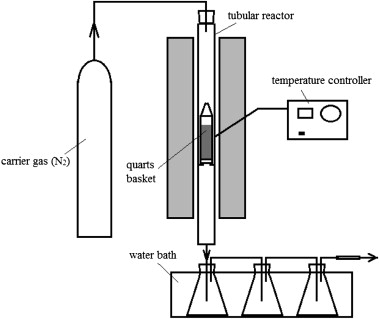Renewable energy is imperative to human beings for the coming exhaustion of fossil fuels. Biomass is an important renewable energy source but its application is restricted severely due to its low energy density. Converting biomass by pyrolysis or by biochemical method for liquid fuels and for high value chemical is of great advantage. But the research in this field is rather rare at present.
Researchers with Institute of Process Engineering (IPE) conducted experiments on pyrolysis of lignocellulose fermentation residue (LFR) by fixed-bed micro reactor. The pyrolytic liquids were analyzed by gas chromatography combined with mass spectrometry (GC/MS), and the effect of temperature on the liquid composition was investigated.
Besides the aim material of LFR, the pyrolytic behaviors of three other materials of cellulose, acidified alkaline lignin (AAL), and dried distillers grains with solubles (DDGS) were also studied for comparison by Thermal gravimetric (TG) analysis. It was found that the TG weight loss curve of LFR appeared very close to the curve of acidified alkaline lignin (AAL), but different from the material of dried distillers grains with solubles (DDGS, also a fermentationresidue but obtained from liquor producing process). The experimental system by fixed-bed was shown in Fig. 1.
Pyrolysis of LFR by fixed-bedmicroreactor in the range of 430 °C–700 °C was carried out. It was found that the liquid yield had a maximum value at the pyrolytic temperature of 475 °C, when the liquid was taken as the aim product for the pyrolysis of LFR. The effect of temperature on the liquid yield by pyrolysis of LFR was in accordance with the pyrolysis of some other biomass materials metioned previously, while the maximum value appeared at different temperature.
The liquid from pyrolysis of LFR by fixed-bedmicroreactor appeared in two layers. The up layer was an aqueous phase, and the bottom layer was an oil phase. The oil phase of the liquid was mainly composed of phenols, including phenol, methyl phenol, and dimethyl phenol; and the content of dimethyl phenol and fatty acids decreased with increasing pyrolytic temperature. In the aqueous phase of the pyrolytic liquid, besides the most abundant phenols, the contents of small acids and nitrogen containing compounds increased more distinctly; the content of phenol was the highest under higher pyrolytic temperatures.
The support from the National Nature Science Fund was greatly acknowledged. The paper was published in Energy.

Experimental system by the fixed-bed micro reactor(Image by IPE)